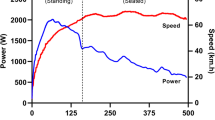Summary
Information about mechanical efficiency during intense exercise is limited, which is partly due to the difficulties that exist in quantifying anaerobic energy production. Based on human studies examining the isolated quadriceps muscle, the mechanical efficiency during intense dynamic exercise has been estimated to be around 22 to 26%. For cycling, the mechanical efficiency shows a wider range (14 to 34%) which, to a large extent, can be attributed to the uncertainties regarding the mass of the muscles used and whether muscle biopsy material is representative for the muscles involved in the exercise. Data from studies of the isolated quadriceps muscle suggest that mechanical efficiency increases as intense exercise is continued and that mechanical efficiency is greater when high intensity exercise is repeated, even with a rest period of 1 hour between exercise bouts. It is unclear whether a period of training can affect mechanical efficiency during intense exercise.
Similar content being viewed by others
References
Morgan W, Martin PW, Krahenbuhl GS. Factors affecting running economy. Sports Med 1989; 7: 310–30
Boobis LH. Metabolic aspects of fatigue during sprinting. In: Macleod D, Maughan R, Nimmo M, et al. editors. Exercise: benefits, limits and adaptations. London: E. & F.N. Spon, 1987; 116–43
Gaitanos GC, Williams C, Boobis LH, et al. Human muscle metabolism during intermittent maximal exercise. J Appl Physiol 1993; 75(2): 712–9
Jones NL, McCartney N, Graham T, et al. Muscle performance and metabolism in maximal isokinetic cycling at slow and fast speeds. J Appl Physiol 1985; 59: 132–6
McCartney N, Heigenhauser GJF, Jones NL. Power output and fatigue of human muscle in maximal cycling exercise. J Appl Physiol 1983: 55: 218–24
Medbø JI, Tabata I. Anaerobic energy release in working muscle during 30 s to 3 min of exhausting bicycling. J Appl Physiol 1993; 74: 1654–60
Bangsbo J, Gollnick PD, Graham TE, et al. Anaerobic energy production and O2 deficit — debt relationship during exhaustive exercise in humans. J Physiol 1990; 422: 539–59
Bangsbo J, Graham TE, Johansen L, et al. Elevated muscle acidity and energy production during exhaustive exercise in man. Am J Physiol 1992; 263: R891–9
Bangsbo J, Graham TE, Kiens B, et al. Elevated muscle glycogen and anaerobic energy production during exhaustive exercise in man. J Physiol 1992; 451: 205–22
Harris RC, Hultman E, Kaijser L, et al. The effect of circulatory occlusion on isometric exercise capacity and energy metabolism of the quadriceps muscle in man. Scand J Clin Lab Invest 1975; 35: 87–95
Wooledge RG, Curtin NA, Homsher E. Energetics aspects of muscle contraction. London: Academic Press, 1985
di Prampero PE, Boutellier U, Marguerat A. Efficiency of work performance and contraction velocity in isotonic tetani of frog sartorius. Pflugers Arch 1988; 412: 455–61
Sargeant AJ, Hoinville E, Young A. Maximum leg force and power output during short-term dynamic exercise. J Appl Physiol 1981; 51: 1175–82
Spriet LL, Söderlund K, Bergström M, et al. Anaerobic energy release in skeletal muscle during electrical stimulation in men. J Appl Physiol 1987; 62: 611–5
Bergström M, Hultman E. Energy cost and fatigue during intermittent electrical stimulation of human skeletal muscle. J Appl Physiol 1998; 65: 1500–5
Lodder MAN, de Haan A, Sargeant AJ. Effect of shortening velocity on work output and energy cost during repeated contractions of the rat EDL muscle. Eur J Appl Physiol 1991; 62: 430–5
Spriet LL, Lindinger MI, McKelvie S, et al. Muscle glyco-genolysis and H+ concentration during maximal intermittent cycling. J Appl Physiol 1989; 66: 8–13
Crow MT, Kushmerick MJ. Chemical energetics of slow- and fast-twitch muscles of the mouse. J Gen Physiol 1982; 79: 147–66
Author information
Authors and Affiliations
Rights and permissions
About this article
Cite this article
Bangsbo, J. Physiological Factors Associated with Efficiency in High Intensity Exercise. Sports Med 22, 299–305 (1996). https://doi.org/10.2165/00007256-199622050-00003
Published:
Issue Date:
DOI: https://doi.org/10.2165/00007256-199622050-00003




